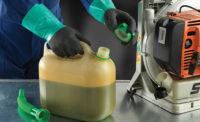
What constitutes a safe transfer system for chemicals or any other fluids? A safe transfer system is one that protects both the operator and the environment. For a system to be safe, the operator should not be subjected to pumps that can leak or cause spills. Likewise, the environment should not be subjected to the results of unsafe pump systems through spillages or through loss of chemicals into the atmosphere.
A third consideration is that there should be no normal chance of foreign matter finding its way into the container holding the subject fluids, be they costly chemicals, liquids used in human consumption or those used in the manufacture of drugs or semiconductors. Such desired systems are frequently referred to as sealed systems.
Weaknesses of conventional systems
The majority of hand-operated pumps being used today do not provide these safety features. They fall into three categories:
- The vertical or pull-action type can be harmful to the operator by virtue of the repetitive arm and hand movement involved in lifting the entire weight of the fluid every time. Additionally, it is difficult to impossible to control the volume dispensed.
- Hand pumps that use a push movement can be harmful because they have limitations similar to those of the vertical or pull-action pump.
- Rotary-action pumps also create similar challenges in protecting both the operator and the environment.
All of these pumps, which have relatively low first costs, actually cost the owner more over time due to the frequency of replacement which may run quarterly to annually. Measurable liquid inventory loss can occur through inaccurate dispensing, and fugitive inventory loss can result from emissions (VOCs) due to the container being open to the atmosphere. Because the above mentioned pumps leave the container open to the air, airborne contaminants can enter and sometimes ruin an entire barrel.
While health hazards to personnel are the primary concern, damage to the facility is another serious problem. And while spills or leaks from failing pumps are costly enough because of the loss of material and the time needed to clean up, there is also the possibility of EPA or OSHA fines should these incidents need to be reported.
Sealed systems provide solutions
On the other hand, there is a class of hand pumps that provide safe transfer of chemicals and most other fluids. This class offers a sealed system where the host liquid is always closed to the atmosphere and where the transfer or flow is totally controlled by a spring-activated tap that shuts off instantly, ensuring that the liquid is never exposed to the atmosphere until it is dispensed.
Such pumps can cost more than unsealed systems, but because they will last ten or more years, they represent good value for the money. Another consideration of this type of pump is that it operates at very low pressures — around 2 to 4 psig. Most operators do not realize that liquids start flowing at 1-2 psig depending upon the viscosity.
This very separate class of pumps comes in four basic models, each with a different elastomer, capable of working with over 900 fluids including solvents, corrosive acids, alkalis, oils, pesticides and more. These fluids are found in every kind of facility, be it electronic, automotive or pharmaceutical manufacturing as well as golf courses, land care and highway maintenance departments.
The body of these pumps is polypropylene, known for its highly chemical-resistant composition and durability (think bowling ball). They weigh less than 2 pounds but can deliver up to 4.5 gallons per minute. The advantages of these pumps include their operation by hand or with shop-air as well the ability to deliver controlled dispensing to a point of use 5 to 10 feet away from the drum. In the correct situation, this eliminates the intermediate transfer to a secondary container with the commensurate risk of spills.
For those facilities with class 1 and 2 flammable liquids, these pumps are offered with static conductive plastic which meets the criteria for NFPA 77. When true zero contaminants are mandatory as in the high technology or pharmaceutical industries, these pumps are ideal.
This series of polypropylene, hand-operated pumps is able to fit most containers from a 2.5 gallon upwards to the 55 gallon barrel. On the receiving side of transferring liquids, the user is able to dispense safely into a cup or pint container in the case of costly chemicals without needing three hands as is the case with the lever, push, pull and rotary pumps described previously. The user will also find that 55 gallon drum meets the standard for RCRA Empty (EPA’s Resource Conservation and Recovery Act) for disposal which is much less expensive.
In closing, it is important that users further educate themselves regarding pumps in the market which provide sealed systems. Such systems contribute significantly to the elimination of spills and evaporation, thus protecting employees and Mother Nature. The pumps’ ability to reduce or eliminate the loss of costly chemicals in the form of VOCs and the protection of expensive inventory from contaminants are some of the benefits afforded to workers when using these dependable pumps over the years.






